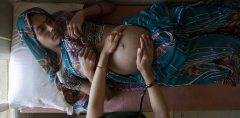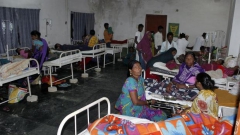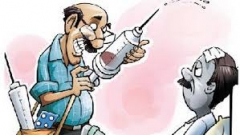04/03/2017
25 million warrior moms give birth every year in India
 In 2000, the Indian Government ratified the objectives of the Millennium for the Development of the United Nations thus committing to reduce child mortality and improve maternal health by 2015.
In 2000, the Indian Government ratified the objectives of the Millennium for the Development of the United Nations thus committing to reduce child mortality and improve maternal health by 2015.
The proposed solution for the India by Indians was: to make sure all women give birth in a hospital.
The proposed method: free care at the public hospital and reimbursement of the transportation costs. And as a side effect, discrediting the dais (traditional Indian midwives with oral and practical knowledge but no diploma) as well as midwives in the Western sense whose profession has been removed of the map – in the 1960s, the India ‘created’ the profession of ‘Auxiliary Nurse Midwives’ to be later replaced by ‘General Nurse Midwives’ (source). All that to encourage women to move away from the traditional system of giving birth at home and rather to go and see the ‘professionals’ at the hospital where treatment could be provided. In itself the idea makes sense I reckon. Yes except that (it’s upsetting, for every measure that the Indian authorities take there is a ‘but’)...
The goal was not achieved despite a huge drop in infant mortality (from 374 per 100,000 births in 2000, it decreased to 174 in 2015 compared to a target of 139). At the same time the number of deliveries at the hospital are believed to have gone up from 25 to 79% according to Unicef (source). Except that it seems that these two trends are in fact not related! But obviously the Government was tempted by the shortcut – who wouldn’t be? But no. According to Jishnu Das, an economist at the World Bank, infant and maternal mortality has fallen ‘simply’ because women are fewer children: 3.3 children per woman in 2000 (5.9 in 1960!) to 2.1 in 2015. I dont completely see the link, but he looked quite sure of himself.
On the other hand it became crazy in the hospitals. And I can testify, since I visit hospitals (public and private) for work.
In the (overcrowded) cities, public hospitals (which do not have the right to refuse patients) are overloaded, with three women sharing a bed when they are lucky enough to find one. With women often treated like shit (because they are poor and illiterate and a doctor is a bit of a God since he saves lives). Or who are slapped by the medical profession when they scream too loudly because of the pain (source). And with women who must give birth alone, because the relatives (even the mother or husband) are not allowed in the labour room.
sharing a bed when they are lucky enough to find one. With women often treated like shit (because they are poor and illiterate and a doctor is a bit of a God since he saves lives). Or who are slapped by the medical profession when they scream too loudly because of the pain (source). And with women who must give birth alone, because the relatives (even the mother or husband) are not allowed in the labour room.
And on the other hand you have understaffed doctors and nurses who have to give birth to dozens of babies at the same time (it is hard to keep your humanity and empathy when you do chain work I guess – in any case that's what thinks the President of the Association of Indian Gynaecologists: “We will first ensure care for all before talking about respect”). And sometimes these professionals get lynched by villagers if everything doesn’t go as well as planned. Literally. Like, they get stoned.
In cities and private hospitals for the richest, abuses are of a different kind, because it’s hard to insult those who sign a (big) check. Here again I can testify with my own delivery and of most of those around me. Abuse or violence takes the shape of ‘forced’ caesarean sections, unnecessary inducements, opening of the cervix by hand. Which sadly doesn’t happen only in India it seems. And then as soon as babies are born they are stuffed with formula (I mean it, they are more often than not given a dose which is three times the size of their stomach so that they sleep and let their mother rest). However preventing newborns to nurse within the first hour can have lasting and damaging consequences for breastfeeding later on.
 Of course there are also ‘good’ doctors. But apart from the fact that they are not easy to find, they are also under pressure from the hospitals which considers the patient rotation as a Key Indicator of Performance. There are also a few birth houses in the country (one in Hyderabad and one in Cochin).
Of course there are also ‘good’ doctors. But apart from the fact that they are not easy to find, they are also under pressure from the hospitals which considers the patient rotation as a Key Indicator of Performance. There are also a few birth houses in the country (one in Hyderabad and one in Cochin).
That’s why we can observe a micro-movement of affluent women who decide to give birth at home accompanied by a trained midwife (i.e. able to recognize when there is an emergency that requires a gynaecologist intervention and a hospital set-up) (source)).
Finally, in the (not overcrowded) countryside, they miss material, blood, qualified doctors, and caesareans required to save lives can not be carried out.
In short the situation is not very simple isn’t it? Not simple, and not glorious.
For the situation to improve we must tell women (all women really because even the educated and privileged ones like me are not aware) that birthing takes time and that it’s okay to not rush things. That birthing bloody hurts but it’s not what matters in the end, because it’s so much more than the pain (without being puppy sentimental), after all “we’re here to suffer” says my father as soon as we start hiking. That birthing is a natural process and that unless there are complications the mother can do everything alone; she’s stronger that she believes and she must trust her body. That episiotomy doesn't need to be systematic. And that regardless of the type of delivery, the baby should be placed on the mother's chest immediately after birth.
People must also make an effort to choose their doctor. The ‘scoring’ system certainly helps: there are websites/apps where patients note doctors and comment on the quality of care they received. This helps to make a more informed choice even though in general there are too many different comments. And when you think that almost 60% of the allopathic doctors in India would actually not have diploma (or even generally not have studied medicine at all), you freak out.
Doctors should agree to come down from their pedestals (at least most of them). Hospitals should get more of them and nurses and the medical cursus needs to be improved (a little bit of patient psychology wouldn’t hurt, but it is my personal opinion).
The idea of trained midwives with a formal curriculum and real responsibilities for non-complicated, non-risky deliveries (a bagatelle in 80% of cases) thus relieving gynaecologists and allow them to focus on problematic births should be seriously considered. That’s apparently what did Sri Lanka successfully, even spending less money than Indian in reducing mortality at birth! (source) And if "Sri Lanka can do it, so can we (India)!" Provided people acknowledge that things are not so pretty here...
08:00 Posted in Incredible India!, My stories in India | Permalink | Comments (0) | Tags: india, childbirth, birth, birthing, labour, maternal mortality, infant mortality, death, infants, c-section, ceasarians, gynec, doctors, nurses, midwives | ![]() Facebook | |
Facebook | |














